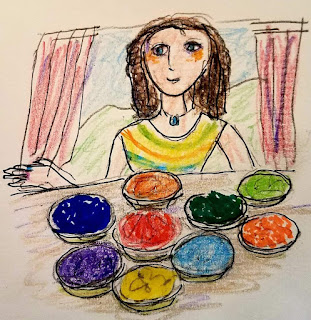Whatever you do as the year turns, write in your journal! Write your dreams from the night, and your dreams of life for the coming year. Write, in particular, whatever you receive from dreams, synchronicity and spontaneous revelation over the last night of the Old Year and the first day of the New Year.
If you were up all night partying - or the effect of your New Year's Eve reveling knocked your dreams out of memory - then record and work with the first dream that comes the following night, and whatever dreamlike symbols the world around you may give you.
In Japan they make a special effort to catch and work with the very first dream of the new year. Many Japanese people pay close attention to Hatsuyume, the first dream of the New Year. It may come in the night of December 31-January 1 but - since many may be up late partying or suffering the after-effects - it may come in the following day or on the night of January 1-2.
I would counsel you to stay alert for dreams for the New Year for a slightly longer period. In my mind the turning of the year rolls from December 30 until January 6, which is Epiphany in the Christian calendar, the day of “showing forth" when the Magi come to Bethlehem following their star, to honor the Christ child. Beyond the religious context, an epiphany may be a sudden revelation or perception of the reality or essential meaning of something important. It may be the gift of a dream.
In hopes of a lucky dream to kick off the New Year, some Japanese invoke the Shichifukujin or "Seven Lucky Gods" and may place a picture of them under the pillow. These may not be part of our belief system, but we have other sources of guidance and blessing available, and it is always appropriate to ask for help and blessing if we do it nicely!
If you are ready to dream in the New Year, you could set the simple intention:
Show me what the New Year will bring.
Or give this a positive spin by couching your request to your dream makers the following way:
Show me the best that life holds for me and those I love in the year ahead.
Be as specific or as general as you like, but ask in a way that excites you and reflects your willingness to receive guidance and enter on new adventures.
Don't forget that dreams require action! Your first action is to record anything you remember from your dreams and the drifty state of hypnagogia. Share it with a friend, if you can, using our Lightning Dreamwork process. Walk with your dream and see how what is going on around you may illuminate the dream and how your dream may illuminate your world.
If you saw things in your dream you don't want to manifest in the year ahead, comb through the material with the eye of a detective, asking Who, What, When, Where, How? If you can clarify the details of the dream and identify where it may play out in coming events, you may be able to take appropriate action to avoid an event you don't want to live through in your physical life. You can also try to accomplish this by going back inside your dream, in a conscious reentry journey, to see whether you can change the script where it was playing. You may want to try writing the story of your dream so it comes to a happy ending. If those approaches feel artificial, however, that may be telling you that physical action is required to reshape the probable future for the better.
If your first dream for the New Year is full of promise, then celebrate - but make it part of your celebration, once again, to take action to embody the energy and promise of the dream and to help it to take root in the world. Don't leave the old year without your journal, and don't enter the new year without your dreams.
May your New Year be filled with abounding joy, and may your best dreams come true!



















